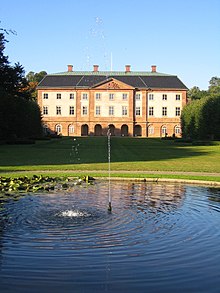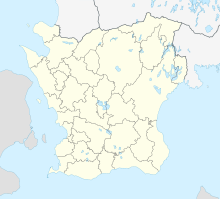Övedskloster Manor
| Övedskloster Manor | |
|---|---|
| Övedskloster slott | |
| Sjöbo Municipality | |

Övedskloster Manor, view from the park
|
|
| Coordinates | 55°41′11″N 13°38′09″E / 55.6864°N 13.6357°E |
| Type | Manor house |
| Site information | |
| Open to the public |
By appointment |
| Site history | |
| Built | 1769–76 |
| Built by | Hans Ramel (1724–1799) |
Övedskloster Manor (Swedish: Övedskloster slott) is a manor in Sjöbo Municipality, Scania, in southern Sweden.
Övedskloster derives its name (Swedish: The monastery of Öved) from a Premonstratensian abbey, founded in the 12th century by the archbishop of Lund, Eskil of Lund, on the site of the present manor. Little is known about the abbey, and there are no visible remains. It was confiscated by the Danish Crown (as the province of Scania was a part of Denmark until the Treaty of Roskilde in 1658) during the Reformation and subsequently turned into a profitable estate, which changed owners several times during the 16th century. A fire sometime after 1594 probably ruined most of the monastic buildings, while others during this time were converted into barns and other outbuildings. Several of the first landowners also did not live at Övedskloster, which was merely used as a profitable source of income. Furthermore, the frequent wars between Sweden and Denmark during the 17th century discouraged any building activity. The monastery therefore relatively quickly fell into disrepair. Still, from a drawing made in the 1680s it is clear that the walls of the former church were still standing at a considerable height, and some of the monastic buildings were intact. During the early 18th century, the estate probably stayed more or less the same way.
In 1753 the estate was sold to Hans Ramel (1724–1799), landowner and member of the Swedish nobility. His wife Amalia Beata Lewenhaupt was born at Övedskloster estate. Hans Ramel was responsible for the complete reconstruction of the manor ensemble, creating the palatial manor house seen today.
Plans had already been made to reconstruct the manor before Hans Ramel assumed ownership. Sometime before 1753 architect Carl Hårleman had produced blueprints for a new manor, as well as a general plan for the park, a new parish church and outbuildings. These plans were largely followed in the ensuing reconstruction, which didn't start until 1759. The first part of the rebuilding scheme was the replacing of the neglected parish church near the manor with a Rococo church, built in 1759–1761.
...
Wikipedia

